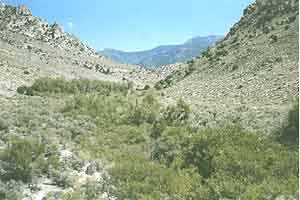
We celebrated Labor Day weekend by traveling to Troy. Not the one in Asia Minor with the big troublemaker named Helen, the other one, up a narrow canyon that spills out of the Grant range into Railroad Valley about halfway between Tonopah and Ely.
The six of us had set out from Tonopah after an early breakfast at our hotel, driving east on US 6 to Warm Springs, then southeast 16 miles on the ET Highway (Nevada 375) to the Nyala Road turnoff on the left. The Troy Canyon turnoff is 3 miles past Nyala, 22 miles from the pavement.
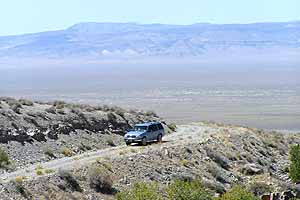
Troy came to life here when a prospector named Alexander Beatty discovered silver in 1867 and a few dozen miners took up residence in tents and gopher holes.
Late in the year the Old English Gold Corporation bought up several claims and in 1869 a representative of the company appeared in Lancashire County, England, seeking financing to develop the mines. A consortium of wealthy gentry and other eager investors sent Captain Aitken to Troy in early 1870 to inspect the prospect and take samples personally.
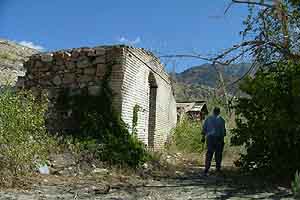
If his entry into the canyon was like ours — the day sunny and bright with a riffling breeze to blow the dust of our passage away — he’d have been half-sold on the proposition before he even got down off the wagon. The road is easy except when the creek is running deep, and it winds up Troy Canyon in a pleasant and picturesque fashion to arrive after about four miles the ruins of Troy. A dozen antelope cantered quickly away from us as we turned off the main road. The mountain summits loom like the spine of a sailbacked dinosaur. Any family sedan can make this drive; the biggest challenge is the thick growth of willows into the roadway where it crosses the stream, scratching your nice new paint.
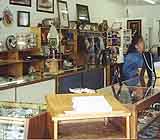 In Ely, we metamorphosed from explorers to shoppers, and found some things to like.The Smoke Signals Trading Post on Aultman Street has a great range of products and prices, a good selection of jewelry, interesting artifacts, and a very knowledgeable staff. The kids both found affordable souvenirs for themselves. At the train depot Delaine Spilsbury had an outdoor display of Native American jewelry for the Trains, Planes & Automobiles event. There’s a small train-themed gift shop at the depot, best for younger children. We bought train track bookends at the RailWay place a few blocks east of the depot. Aside from pastries, the Steptoe Valley Inn has hand crafted goats milk soap from the Double Bar 3. Robin picked up the Bay variety and says it’s very yummy. Coming home via US 50 we liked the Owl Club gift shop in Eureka. In Austin, the Main Street Shops has a huge selection of improvements for home, body and mind. Also, in the blue building near the top of town, Patsy always has some Austin original bath salts that fizz cheerfully when they hit the water. |
The puny remnants of the old town are an impressive mill chimney, a brick and stone building (a store?), a log cabin, another stone building down by the creek, and another swallowed up by the willows farther upstream. There’s a small cemetery that takes some searching to find (upstream, then across the stream on a track that was once a road, with willows on one side and wild holly on the other). The mine itself is on private property and not accessible.
The values in Captain Aitken’s ore samples persuaded the Lancashire investors to go ahead, and they formed the Troy Silver Mining Company. Construction and development work began on the mine and mill before the end of 1870.
According to Stanley Paher‘s classic Nevada Ghost Towns and Mining Camps, “By 1871 Troy had two general stores, boarding house, blacksmith shops, school, unofficial post office and the population numbered 70 miners and their families. The English company expended $500,000 in mining development and in building a modern 20-stamp mill with furnaces, completed in 1871.”
Not long after, the mill produced its first riches: two silver bars. Eventually it produced ten more. Total.
The literature does not tell us how much the bars weighed, but it was clearly not nearly enough.

From a Forest Service brochure: “Managers were constantly asking for more funds, citing flooding of the mine, possible strikes by miners, bank overdrafts and constant small glitches in the mill equipment. . . . Work stopped in 1875 and equipment was sold and sent to the new mineral discoveries at Ward. Anyone who invested in Troy lost their money.” Paher says some mining was done here as recently as 1946. There were some burnt bedsprings in a clearing to suggest even more recent occupants.
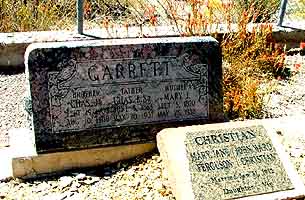
We prowled the district for a couple of hours, leaving footprints and taking photographs. There was one other carload of folks exploring the site while we were there.
Departing Troy we resumed our northeast passage on the Nyala Road up Railroad Valley to the junction with US 6, which we took for the last 61 miles into Ely and comfortable rooms at the Hotel Nevada.
It was a highly enjoyable trip, low key and comfortable, and I recommend that everyone visit Troy at least once in a lifetime, except that Helen bitch.
Happy Highways,



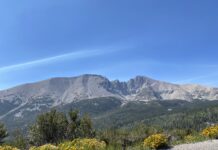
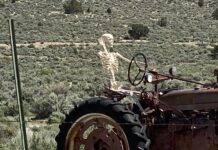
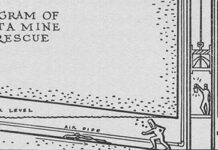
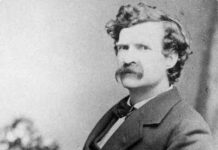
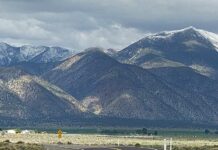
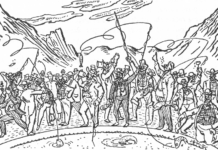






I was so thrilled to locate the graves of my grandmother, Mary Jane Ferguson, and also my grandfather Garrett.